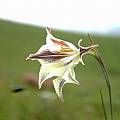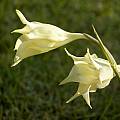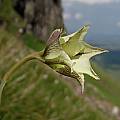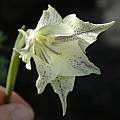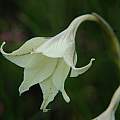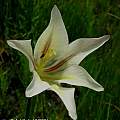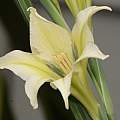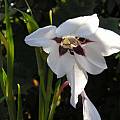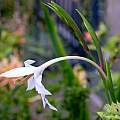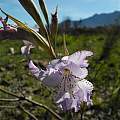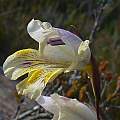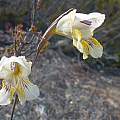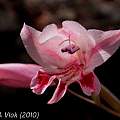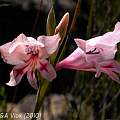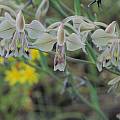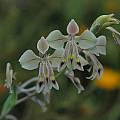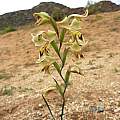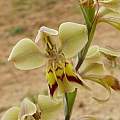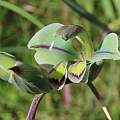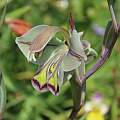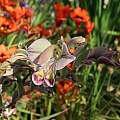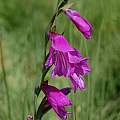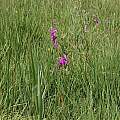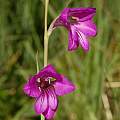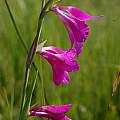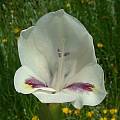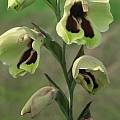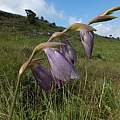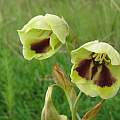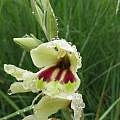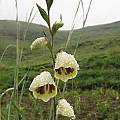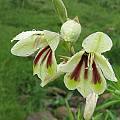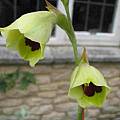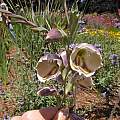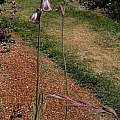These colors are often associated with moth pollination, and so some of the most fragrant Gladiolus can be found in this category. Another big group in this category are those species who have occasionally some kind of albino form - rare in nature, but eagerly adopted by gardeners when found.
Page 1: G. acuminatus... Page 2: G. floribundus... Page 4: G. parvulus... Page 5: G. sekukuniensis...
Gladiolus longicollis Baker is a species found in a wide area of southern Africa, including the southern Cape, the eastern Cape, the Free State and the Northern Province. It has pale yellow to white long tubed flowers that are either uniformly colored or mottled with brown. Flowers are night blooming and sweetly scented of carnation and cloves. There are two subspecies:
Gladiolus longicollis ssp. longicollis has a shorter perianth tube and transparent upper tepals and flowers October to November. It is found from Oudtshoorn in the Western Cape through the Eastern Cape and Free State and into Lesotho and Gauteng where it usually grows on moist, south facing slopes in low grassy fynbos or rocky grassland.
Gladiolus longicollis ssp. platypetalus (Baker) Goldblatt & J.C.Manning has a longer perianth tube and broader petals with the outer whorl tepals longer than the inner whorl and grows in rocky grasslands from central KwaZulu-Natal to Mpumalanga and Limpopo. Its flowering season extends into January and possibly February.
The first three photos from Cameron McMaster and the next two from Mary Sue Ittner. Photos three thru five were taken at Naude's Nek.
The first photo from the book Plants of the Klein Karoo courtesy of Jan and Anne Lise Schutte-Vlok. They describe it as growing up to 60 cm tall with narrow cylindrical leaves and flowers with red brown spots and lines. The anthers are not much exposed, a characteristic that helps distinguish it from a similar looking Gladiolus tristis. The second photo is from Arnold Trachtenberg.
Gladiolus murielae syn. Acidanthera bicolor , Gladiolus callianthus , and Acidanthera murielae is a species with a wide distribution from northeastern Africa southward to Mozambique. It is often sold or described under the Acidanthera synonyms or, as it is most common in northern Ethiopia, sometimes called Abyssinian gladiolus. This species has long tubed white flowers with dark purple markings in the midline on the lower tepals or all tepals and is fragrant, more strongly at night. Since it comes from a tropical climate, it is often protected in colder climates and dug in the winter and stored and replanted after the last frost so that it will be summer growing, blooming late summer into fall. Photo 1 by Arnold Trachtenberg of plants blooming in the Brooklyn Botanical Garden, Photo 2 by Martin Bohnet illustrates the length of the tube.
Gladiolus mutabilis is an Eastern Cape species and also occurs in the eastern part of the Western Cape. Plants grow in sandstone derived soils. This species has slightly fleshy leaf blades without thickened margins or midribs and an elongated corm that is two to three times as long as wide. Flower color ranges from pale to dark blue, mauve, brown or cream. The lower tepals are usually cream or yellow below with dark blue or brown dots and streaks on the yellow background forming the nectar guide. The fragrant flowers appear early in the season, June or July. The first photo was taken by Rachel Saunders who discovered this plant late July 2012 blooming in an area that had previously burned in the Western Cape. The next two photos were taken by Cameron McMaster August 2012 at the top of Potjiesberg Pass south of Uniondale (Eastern Cape) where it was growing with Gladiolus patersoniae. In the Western Cape population Gladiolus patersoniae was also in flower raising the question of whether they are both pollinated by the same pollinator. The last photo from the book Plants of the Klein Karoo courtesy of Jan and Anne Lise Schutte-Vlok.
Gladiolus nigromontanus Goldblatt is a rare South African species that occurs only on rocky outcrops on sandstone slopes in the Swartberg Mountains. Flowering in autumn (March) and best a few years after a fire, it grows to 30 cm with narrow leaves and small white long tubed flowers suffused light pink and marked with red and yellow on the three lower lobes. Flowers are in a 3 to 6 flower spike. Photos from the book Plants of the Klein Karoo courtesy of Jan and Anne Lise Schutte-Vlok.
Gladiolus orchidiflorus Andrews is found on clay and sandstone soils from Namibia to Cape Flats and also to Free State and flowers in the spring. It has linear to sword-shaped leaves that are thickened in the midline. Flowers are in a 5 to 12 flowered spike, windowed in profile, greenish to purple with dark purple markings on the lower tepals, and are very fragrant. Photos 1-2 are habitat shots taken in Namaqualand by Bob Rutemoeller and Mary Sue Ittner September 2006. Photos 3-4 were taken near Carolusberg, Namaqualand by Cameron McMaster September 2011.
The photos below were taken by Alan Horstmann.
Gladiolus ornatus Klatt is found on marshy sandstone and granite slopes in the Southwestern Cape, South Africa. Growing from 25 to 35 cm high, it has linear leaves and pink unscented flowers in a funnel shaped tube in a one to three flowered spike. The lower tepals each have a spear to spade shaped white median streak edged in dark pink and the lower part of the throat is white streaked with dark pink. Flowering is from September to November. Photo by Rachel Saunders.
Gladiolus palustris Gaudin is native to central and northwestern Europe, the most northerly range in the genus, and is suitable for ordinary to moist border conditions, as well as a bog garden. The normal flower color is rosy violet. Photos 1-4 from Hans Joschko. The pictured white form in photo 5 from Jane McGary was grown from seed sent by Ole Olsen of Norway, who cultivates the parent plants as a "blue" form. This species faces only one direction and does not have more than 6 flowers on a spike. We have been told this may be misnamed, but have not been given another name.
Gladiolus papilio Hook.f. (syn. G. purpureo-auratus, G. brachyscyphus, G. spathulatus, G. schlechteri) is called the Butterfly Gladiolus, and grows in marshy ground, up to 2400 m, from the Eastern Cape to Limpopo Province. It is claimed to be a hardy garden plant, grown in the UK since 1866. The first two photos were taken by Roy Herold in KwaZulu-Natal Province, near Kamberg in the foothills of the Drakensberg, in early December 2006. The third was taken by Rod Saunders. The fourth, an unusual color form, was taken by Rachel Saunders in the mountains above Tzaneen, early January 2015.
The photos below were taken by Cameron McMaster in Lesotho.
The first photo from John Grimshaw is of a form he labels in the "purpureoauratus" group. The second and third photos were taken by Bob Rutemoeller in the Mendocino Coast Botanical Gardens.
Page 1: G. acuminatus... Page 2: G. floribundus... Page 4: G. parvulus... Page 5: G. sekukuniensis...
